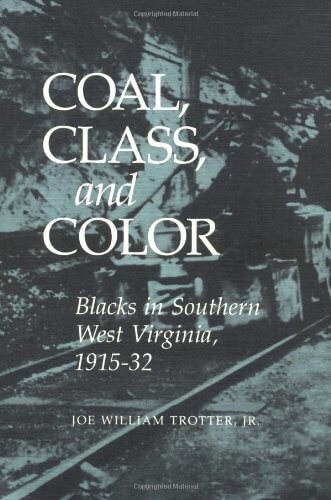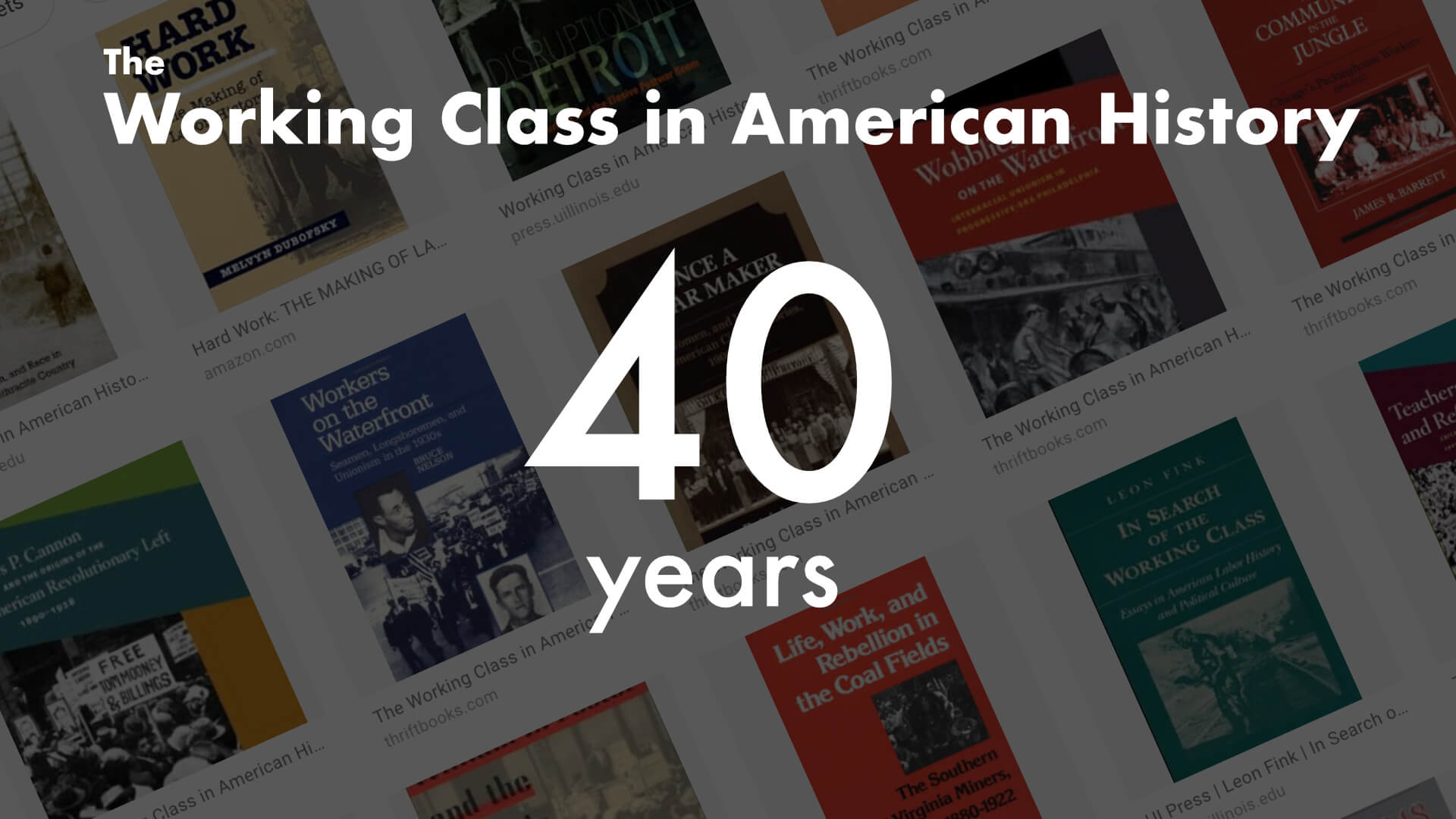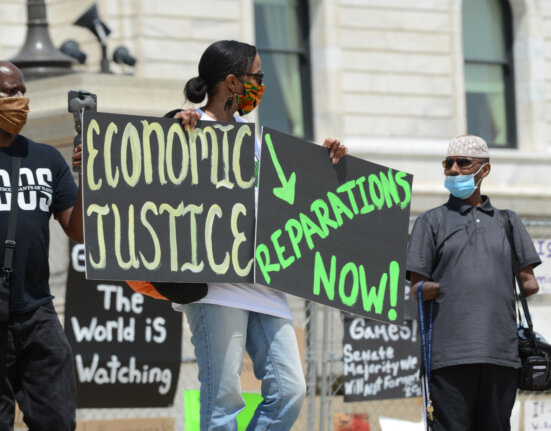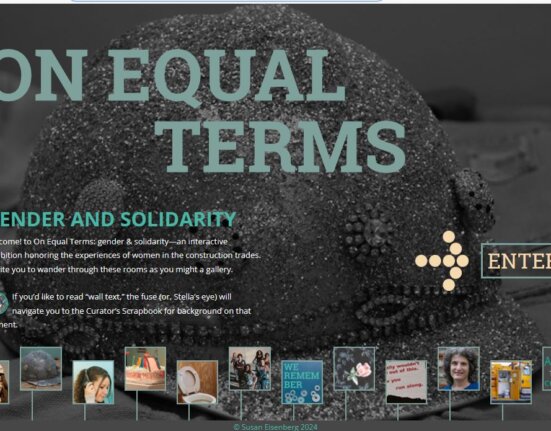We continue our commentaries about the important contributions and critical reviews of the remarkable Working Class in American History Series, which is celebrating its 40th year in 2018. The series began when labor history as a field was beginning to make inroads into the dominant narratives of U.S. history. Since that time over 130 books in labor history have been published. In late October, at a special session at the Newberry Library in Chicago, panelists surveyed and made comments about their perspectives on the accomplishments and limits of the series. We publish these commentaries in this series, and welcome your response to them. Panelists include series editors Julie Greene, Jim Barrett, and Nelson Lichtenstein, and series authors Joe William Trotter, Jr., Jessica Wilkerson, Toby Higbie.
“Celebrating the 40-Year History of the Working Class in American History Series from the University of Illinois Press, 1978-2018: A Perspective from the African American Field”
I wish to thank the Newberry Library and the University of Illinois Press for the opportunity to participate in this important celebration of publishing accomplishments. I especially wish to thank Liesl Orenic and Leon Fink for organizing this session. As other commentaries have made clear, we are not only here to celebrate the immense intellectual achievements of the Working Class in American History Series. We are also here to reflect on the state of the field, including our own particular journey into the study of labor history; to consider ways to respond to the current political moment in the nation’s history, and, most of all suggest agenda for the next generation of work on labor and working class history moving forward. In my opening comments, I would like to underscore the role of the University of Illinois Press in the growth and development of the African American field.
When I enrolled in graduate studies over forty years ago, I had no idea that the University of Illinois Press would eventually publish two of my books. The rejection letter that I had received from the University when I applied to graduate studies in history there was fresh in my mind. When I arrived in Minnesota in 1975, the UIP Blacks in the New World Series (BNW) was only two years old. It contained only two books, David Katzman’s Before the Ghetto (1972) and Walter Weare’s Black Business in the New South (1975). The Working Class in American History Series (WCAH) was three years away. Thus, the two series that would play such a pivotal role in my career were just getting underway. Moreover, the book that first defined me as an historian of the black working class, Black Milwaukee: The Making of an Industrial Proletariat, 1915–1945 (1985), appeared in the Blacks in the New World Series rather than the WCAH. Five years later, however, I was especially pleased when the University of Illinois Press published my second book, Black Milwaukee: the Making of an Industrial Proletariat, ( 1990), in both the WCAH and BNW series.

In 1983, five years after the founding of the WCAH, historians Michael Frisch and Daniel Walkowitz published their agenda-setting collection of essays, titled Working Class America: Essays on Labor, Community, and American Society. They celebrated the expanding accomplishments of the new labor and social history. They also noted that the new trends had not yet, as they put it, “blended with Black and Hispanic history, to the detriment of both.” Today, thanks to the Working Class in American History series, nearly a half century of scholarship has fueled the emergence of African American labor and working class history as a dynamic field in U.S. labor studies. As a body, research on black workers underscore the complicated intersections of class, race, and gender with increasing attention to sexuality and transnational connections. Late 20th century and early 21st century studies—by Kimberly Phillips, Melinda Chateauvert, Brian Kelly, Will Jones, Jessie Ramey, Peter Cole and others reinforced and very often moved well beyond the earlier pioneering contributions of John Bodnar, Peter Gottlieb, Michael Honey and somewhat later Rick Halpern and Roger Horowitz.
As new studies came online, they exerted an extraordinary impact on subsequent work within and beyond the WCAH series. In 1981, for example, the University of Illinois Press published the second book in the WCAH series, David A. Corbin’s Life, Work, and Rebellion in the Coal Fields: The Southern West Virginia Miners, 1880-1922. Corbin’s book set the stage for the transformation of scholarship on the dynamics of class and race in the coalfields of Southern West Virginia and beyond. He offered the provocative conclusion that the “nature of the company town focused the workers’ discontent, not on each other nor on a racial or ethnic group, but upon the employer—the coal operator—enabling the miners to develop that sense of group oppression necessary for class feeling and behavior.” (p. 61). Corbin’s insistence on the salience of class over race established a powerful intellectual backdrop, empirical foundation, and challenge for subsequent studies of the coalfields that influenced new scholarship within and beyond studies in the WCAH series. These studies include my own Coal, Class, and Color; historian Ronald Lewis’s Black Coal Miners in America (University of Kentucky Press, 1987); and the late Jim Green’s study, The Devil is Here in These Hills: West Virginia Coal Miners and their Battle for Freedom (Atlantic Monthly Press, 2015).
But this is not all. In 2016, PBS aired Randall McLowery’s popular film, “The Mine Wars.” Based mainly on Jim Green’s book, this film owed a great deal to University of Illinois Press publications. As such, the press played an important part in helping to bring knowledge of this significant battle for democracy in the nation’s history to a broader audience. Jim passed away in 2016, but not before he saw the first cut of the film. As historian Lou Martin puts it in a recent review of Jim’s work in West Virginia History, a special spring and fall issue (2018), “he was especially pleased that so many West Virginia historians . . . were interviewed and had their work showcased.” Jim’s work on West Virginia miners also highlights the role of the WCAH in fostering intergenerational relations among younger and more senior scholars. Lou Martin himself served as a research assistant for Green’s mine wars book. He is also one of the youngest recent contributors to the WCAH series, with publication of his Smokestacks in the Hills: Rural-Industrial Workers in West Virginia, which won honorable mention for the OAH David Montgomery Award for the best book in labor history in 2016.
This is also a good transition for me to share a bit about my own journey into the field of African American and U.S. labor and working class history. Intensely personal as well as intellectual concerns motivated my research on Milwaukee and coal miners in southern West Virginia. When I entered Graduate Studies in History at the University of Minnesota, I had just completed a 6-year teaching career at Tremper Senior High School in Kenosha, Wisconsin, home of the American Motors Corporation, the mainstay of the city’s industrial economy. During my high school teaching years, I joined other activists and community organizers in a struggle to help transform the local fight for Civil Rights into a Black Power Movement. The notion of race first, Black consciousness, and the unity of African people was very much at the center of our efforts and my own shifting political consciousness.
By the end of my third year of teaching and community work, however, I became increasingly convinced that these two very powerful structural forces (race and class) could not be conveniently or easily separated in theory or practice. Thus, when I entered graduate school in 1975, I was exceedingly receptive to the emerging class analyses of the new labor and social history movements that were taking hold in the academy at that time. I was profoundly influenced by the ideas of David Brody, David Montgomery, and Herbert Gutman. But my intellectual journey to the working class owed as much and even more to class formation studies of black workers on the African continent, including parts of East, South, and West Africa. Specifically, it was a seminar paper on comparative class formation in South Africa and industrializing Alabama that confirmed my interest in revamping our understanding of black urban history from the vantage point of black workers.
On another level, my journey to research on the black working class was also determined but not predetermined by my deep roots growing up in a working class family in the Southern West Virginia coalfields. I was born in Southern West Virginia. I am a product of a large coal mining family of 14 children (10 sisters and 3 brothers). My mother and father migrated to the coalfields from the Birmingham District in Alabama during the late 1930s. Following my father’s untimely death in 1957, my mother, now a widow with 12 children still living at home, soon moved the family to Newcomerstown, Ohio, a small town just south of the Massillon-Canton area. As I ponder my intellectual development and career as a historian, it is clear that my scholarship on black workers is deeply rooted in my family’s history as well as certain intellectual currents taking hold in the academy during my early foray into the field of African American and U.S. urban labor and working class history.
In closing, I would like to conclude with a few thoughts about how we might respond to the current moment in labor history, along with some very informal reflections on areas for the next round of scholarship on working class black history. Perhaps the best way to respond to the current political moment is to continue to deepen our research, writing, and understanding of the working class across all categories of experience and difference. Too often, the white working class considers itself the pillar of the American working class, with other constituents of the working class defined, not as workers, but as members of particular ethnic, racial, nationality, and gender groups. Addressing this misleading conception of the working class would seem imperative in the current political climate.
As for the next round of scholarship on the African American working class, much work remains to be done across all time periods, regions, topics, and themes, but I will highlight three areas for consideration. In summary, first, Tya Miles’s recent study, The Dawn of Detroit: A Chronicle of Slavery and Freedom in the City of the Straits (2017), has caught my attention. It illuminates the enslavement of people of African and indigenous descent in early national and colonial Michigan, and suggests that other Midwestern cities might well benefit from a closer and more detailed assessment of enslavement than we currently have at our disposal. Second, as part of a generation of historians who found the notion of “ghetto formation” in research on the black experience exceedingly limiting, I recently revisited this notion in an A. W. Mellon funded Sawyer Seminar on the ghetto in global history. This seminar resulted in an edited volume on the subject with Russianist Wendy Goldman—The Ghetto in Global History (Routledge, 2018). Focusing on a variety of European, South African, and U.S. cases, this volume suggests that a new generation of young scholars might very well return to the notion of ghettoization as a highly class inflected form of racialized spatial segregation in transnational perspective.
Third and finally, with the advent of new digital technology, I believe that it is time to gradually bring the opening decades of the 21st century under careful historical scrutiny. We have paid a good deal of attention to the collapse of the old industrial order (though we have by no means exhausted this field), but have given little historical attention to the process by which the new order has taken shape and with what precise consequences for African American workers. This could turn out to be the most promising field for the next round of urban historical research on the lives of black workers within and beyond the United States. As suggested by Barbara Ransby’s new book, Making all Black Lives Matter (2018), no doubt a young generation of scholars who have come of age in the fires of the Black Lives Matter Movement and Movement for Black Lives will help pioneer the development of this field.
In short, the next generation of scholars of African American and U.S. urban labor and working class history has an extraordinary opportunity to push our understanding into fresh new directions. I am also convinced that the University of Illinois Press, through the Working Class in American History Series, will also help to bring this postindustrial history to fruition. For all that it has done to advance knowledge on these important issues in the history of the nation, I wish again to applaud and thank the University of Illinois Press.

Joe William Trotter, Jr. is Giant Eagle Professor of History and Social Justice and Founder and Director of the Center for Africanamerican Urban Studies and the Economy at Carnegie Mellon University. He is the author of Workers on Arrival, Black Milwaukee, and Coal, Class, and Color and past President of the Labor and Working Class History Association.
Title needs to be shortened from below: How about including the longer title interior? And shortening it in the official title to “The Working Class in American History Series: A Perspective from the African-American Field”






